Eyes and eyelids
Dr Mike Wyndham
Dr Mike Wyndham is a GP in a suburban practice in Edgware Middlesex He has always been a keen photographer, and has been taking medical photographs for more than 25 years. He has been a regular contributor to the GP press and his work has also appeared in the British Medical Journal, The Pharmaceutical Journal and various medical text books
Conditions affecting the eyes and eyelids can be painful and disfiguring, but while some may respond to simple self care measures such as compresses or bathing, others require more aggressive intervention
BLEPHARITIS
Blepharitis is an inflammation along the eyelid margin and may be divided into two origins: anterior, which is on the outside edge of the eyelid; and posterior which affects the meibomian glands, which are just inside the eyelid. Staphylococcal infection is the usual cause of the anterior form, and conditions such as rosacea and seborrhoeic dermatitis cause the posterior form. Treatment includes the use of a warm compress on the eyelids in the morning with some gentle massage to remove any crusts. To clean the eyelids, a solution of sodium bicarbonate (1 teaspoonful to a cup of boiled water that has been allowed to cool) should be used. I suggest dipping a cotton bud into the solution and cleaning the lids. Occasionally the lids may become infected and antibiotic drops are required. Where there is rosacea, antibiotics such as oxytetracycline may be needed.
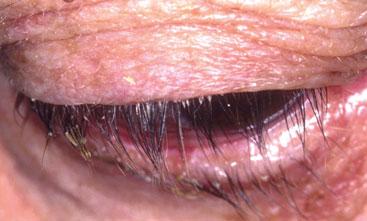
INFECTED MEIBOMIAN CYST
The meibomian glands, which are located inside the eyelid, secrete a fatty substance into the tear film that enables the eye to remain lubricated. When the duct from the gland becomes blocked, the secretions have nowhere to go and this predisposes to the development of a cyst - a nodule containing fluid or pus. These are more likely to develop in people with conditions such as blepharitis and acne rosacea. They can be differentiated from a stye, which manifests as a localised infection at the base of an eyelash. Treatment includes massaging the cyst with a warm flannel to see if this will encourage drainage. The cyst in this picture was infected and required a course of flucloxacillin. If this cyst remains it may be surgically removed.
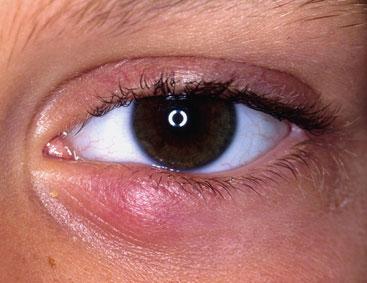
GIANT PAPILLARY CONJUNCTIVITIS
This eyelid belonged to a sufferer of allergic conjunctivitis, which was one of his symptoms of hay fever. His symptoms included intensely itchy eyes with the sclerae becoming red and the eyelids a little swollen. The eyes were a little sticky in the morning but there was a clear watering of the eyes from time to time during the day. Anti-allergic eye drops such as sodium cromoglycate or anti-histamine drops may be helpful in allergic conjunctivitis but in view of the severity of this patient's problem steroid eye drops were required. Care must be taken with the use of the latter when treating the 'red eye' to avoid the dangers of accidentally using them in a herpes simplex infection. Giant papillary conjunctivitis may also be found in contact lens wearers.
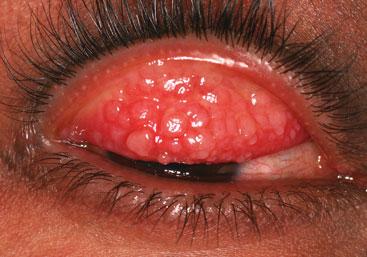
PTERYGIUM
A pterygium is a benign growth that originates from the conjunctiva and slowly grows across the eye. It often has a triangular appearance. It is more likely to develop in those who live in hot climates or in those exposed to dusty or sandy environments. The growth is usually a white tissue with associated fine blood vessels. They are usually asymptomatic but may cause irritation. Treatment is not usually required unless they cause blockage of the visual field. This takes the form of surgical removal. Recurrence may occur after removal.
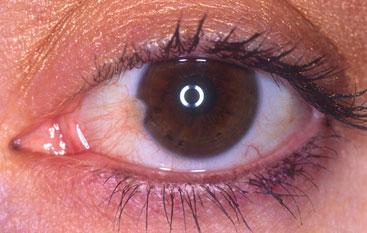
ORBITAL CELLULITIS
Orbital cellulitis arises from infection behind the orbital septum, which should be differentiated from pre-septal cellulitis, which manifests as infection in the soft tissues around the eye. The infection may develop from extension of infection from around the eye but more commonly occurs as an extension of infection in the paranasal sinuses. It is more common in children than in adults. Signs include ophthalmoplegia and proptosis. It is extremely important to make a speedy diagnosis as loss of eyesight is a risk in this condition. Antibiotics are required and sometimes surgery.
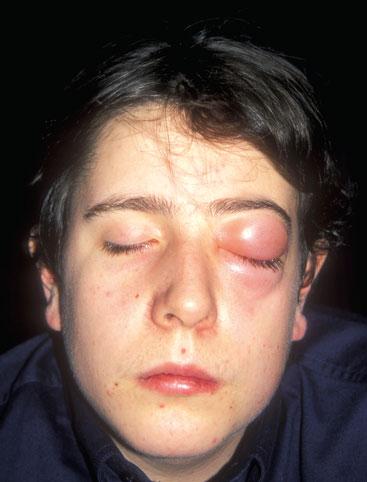
EPISCLERITIS
This condition is where the episclera, a layer of tissue between conjunctiva and the sclera, becomes inflamed. The condition usually develops in young adults and often only affects one eye. The attacks usually only last a couple of weeks unless there is an associated underlying condition. The appearance is of a localised area of redness and the patient may complain of irritation and discomfort. The condition may recur. In about 30% cases, there may be an associated underlying condition such as Crohn's disease. The eye may need treating with steroid eye drops, which should be prescribed under the guidance of an ophthalmologist. Nodular episcleritis can be treated with flurbiprofen.
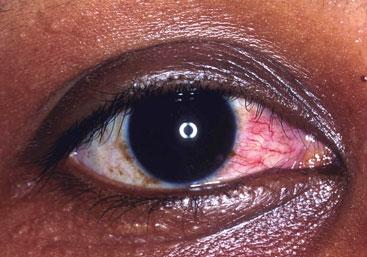
Related articles
View all Articles